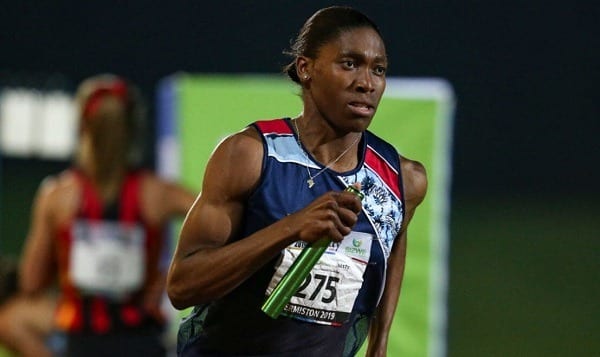It could be, however, her last race as an 800m specialist, thanks to a discriminatory rule set to be enforced by the International Association of Athletics Federations (IAAF) restricting testosterone levels for women athletes over middle-distance track events.
Earlier in the week, Semenya lost her case with the Court of Arbitration for Sport (CAS) in appealing the rule, which many argue has been imposed specifically to restrict her participation in athletics.
In announcing their findings, CAS acknowledged the ‘discriminate’ nature of the IAAF’s rules, but argued that such rules are necessary to ‘preserve the integrity’ of women’s sport.
Findings from a study commissioned by the IAAF, submitted in evidence to CAS, show that women with higher than average levels of testosterone have an advantage in the 400m sprint, 400m hurdles, 800m, hammer throw and pole vault.
The IAAF, however, has chosen not to implement testosterone restrictions for the two sports where women with high testosterone were shown to have the biggest advantage, pole vault and hammer throw, indicating a pre-mediated intention to actively target Semenya.
Because we conceive of male athletes as the pinnacle of human ability, their genetic advantages are celebrated without question, like Michael Phelps’ ‘elongated wingspan’ and ‘abnormally large, double-jointed feet’. But for the women athletes who challenge our limited understanding of biological sex with their incredible talents, their genetic makeup is heavily scrutinised and subject to handicapping for pushing the acceptable boundaries.
Semenya has been marginalised by the same institutions who have only devised two categories for athletic competition – male and female – and who are now seeking to disqualify her for her perceived nonconformity to their restrictive binary groups.
The thing is, biological sex is not just black and white.
Differences in sexual development (DSD) mean some people are born with ambiguous genitalia, have internal organs or hormones of the opposite sex, or different chromosomal combinations. Some people will live their whole lives without even knowing they are intersex.
Semenya is hyperandrogynous, which means she has higher levels of testosterone than most women – but does that make her ineligible to compete in women’s sport?
African activists are tired of having African women’s bodies judged against western standards. As far as Semenya and her family is concerned, she was born a girl, and that is final.
Semenya is far from the only woman athlete to have her body policed by restrictive standards.
Tennis great Serena Williams was banned from wearing her infamous catsuit to this year’s French Open because it didn’t ‘respect the game and the place’.
The outfit was worn in part to prevent blood clots, after the difficult birth of Williams’ daughter during which a blood clot formed and nearly killed her. But the Williams sisters have long been victims of body-shaming, and are also routinely subject to commentary on their appearances and outfit choices.
French tennis player Alize Cornet was then given a ‘code violation’ at the US Open for fixing her shirt, which was back to front, during play.
Cross country athletes at Rowan University in the US were banned from wearing just their sports bras to training, and were also forced to relocate their training sessions to the local high school after ‘distracting’ the university’s male football team.
Our policing of women’s bodies is even more pervasive – and life threatening – when it comes to cultural norms and laws.
The history of medical care in various countries has been profoundly sexist, limiting women’s access to unbiased medical advice, procedures and medication.
In the 1970’s, 98 per cent of gynaecologists in the US were men. Single women were prevented from accessing the contraceptive pill, and it was reportedly common practice for women’s doctors to refer diagnoses like STD’s on to their husband instead of the woman patient.
The stigmatisation of women’s health issues like abortion is still all too common. It’s symptomatic of patriarchal social regimes in which physically policing women’s bodies has historically been the domain of men.
Ireland’s constitution outlawed abortion until May last year, when an historic referendum resulted in a majority vote to legalise it.
The referendum was too late for Savita Halappanavar, who died of complications from pregnancy after being refused an abortion that could have ‘almost certainly’ saved her life.
Ireland’s tragic legacy of exerting strict control over women’s bodies, however, runs far deeper than criminalising abortion.
Up until 1996, the Roman Catholic Church were operating Magdalene laundries, where ‘fallen women’, orphans and abused girls were condemned to work to serve ‘penance’ for their ‘sins’.
The Catholic Church profited off the exploitation of women – who were abused, housed in deplorable conditions, denied an education and given little or no pay – as retribution for ‘deviant’ behaviour, like having children outside of marriage and ‘being flirtatious’.
Others, including orphans, simply had nowhere else to go.
Another woman told of being sent to work at a laundry after she was raped – and others still were raped by priests and others while in the laundries’ care.
While the decriminalisation of abortion in Ireland legally ends the Churches’ control over women’s autonomy of their bodies, the lasting impacts of cultural Catholicism mean there is still a sizeable opposition to the fundamental right of women to seek abortions.
Back home, it is still illegal for women in New South Wales and Queensland to seek abortions for anything other than serious physical or mental health side effects of pregnancy.
These laws have persisted in a political landscape where men comprise 68 per cent of politicians in our federal parliament, and approximately 67 percent and 68 percent of NSW and QLD’s state parliaments respectively.
It may be surprising, then, that statistics suggest that up to a third of Australian women will seek an abortion in their lifetime.
Caster Semenya denies she plans to retire, and Serena Williams will undoubtedly once again push the boundaries of sports fashion. But for the women who have perished or those who still bear the traumas from their time in Magdalene laundries, and those who have been denied abortions, the policing of their bodies has cost them greatly.
This policing of women’s bodies, in standardising the acceptable levels of a naturally-occurring hormone, in enforcing a sexist dress code, in denying women their freedom and human rights, must stop. How we look, what we’re capable of, what we wear, and what happens to our bodies is up to us to determine.


